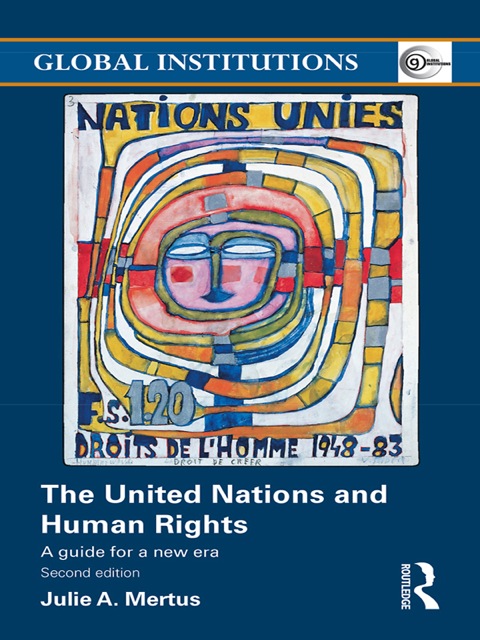Description
Efnisyfirlit
- Routledge Global Institutions
- Contents
- Illustrations
- Figures
- Tables
- Boxes
- Foreword to the second edition
- UN human rights machinery
- Acknowledgments
- Abbreviations
- 1 A guide to the new UN human rights practice
- What is the new UN human rights practice?
- Where does UN human rights work happen?
- Who are the actors?
- Organization and goals of this book
- 2 The Office of the High Commissioner for Human Rights
- Origins and organization
- Genesis of an idea
- Contribution of world conferences
- Mandate and organization
- Key activities of OHCHR
- Technical assistance
- Country offices/regional offices
- Other forms of field presence
- Bosnia and Herzegovina: the OHCHR field office at work
- OHCHR support of national human rights institutions (NHRIs)
- Preliminary evaluation of the individual High Commissioners
- Concluding thoughts
- 3 UN Charter-based bodies (and other non-treaty bodies)
- Overview of Charter-based bodies
- The General Assembly
- The Human Rights Council
- Establishment and mandate
- Criticism of the Council
- The Sub-Commission
- The Economic and Social Council (ECOSOC)
- The Commission on the Status of Women
- Additional non-treaty bodies concerned with human rights
- The International Court of Justice31
- The United Nations High Commissioner for Refugees
- The United Nations Children’s Fund (formerly known as the United Nations International Children’s Emergency Fund)
- The United Nations Development Programme
- Operation of Charter-based bodies
- Standard-setting activities
- Protection activities: 1235 and 1503 procedures
- Special procedures: working groups and thematic procedures
- Rapporteurs’ dialogues
- NGO participation in mechanisms
- Concluding thoughts
- 4 UN treaty bodies
- Overview of the work of human rights committees
- State reporting
- Communications
- Procedure of inquiry
- General comments
- Thematic discussions
- National plans of action
- Overview of specific treaty bodies
- Human Rights Committee
- Are individual communications permitted?
- Committee on Economic, Social and Cultural Rights
- Are individual communications permitted?
- The Committee on the Elimination of Racial Discrimination
- Are individual communications permitted?
- Committee on the Elimination of Discrimination Against Women
- Are individual communications permitted?
- Committee Against Torture
- Are individual communications permitted?
- The Committee on the Rights of the Child
- Are individual communications permitted?
- Committee on the Protection of the Rights of All Migrant Workers and Members of Their Families
- Are individual communications permitted?
- Committee on the Rights of Persons with Disabilities
- Are individual communications permitted?
- Committee on Enforced or Involuntary Disappearance
- Pressures for reform
- Concluding thoughts
- 5 The Security Council
- Human rights before the Security Council
- Authority and will to address human rights
- Measures to promote human rights
- Non-coercive measures
- Coercive measures
- Humanitarian intervention and the responsibility to protect
- Holding the UN accountable
- Reform efforts
- Transparency, expansion, and voting
- Opening the Council, the Arria Formula, and beyond
- Advocacy by non-governmental organizations
- Concluding thoughts
- 6 The International Labour Organization1 and the UN Global Compact
- ILO organizational structure and operations
- Linking trade and labor
- The social clause debate
- Standard-setting
- Follow-up
- Enforcement mechanisms
- State reports
- Complaints
- Case study on child labor
- New standards: Convention 182
- InFocus Programme on the Progressive Elimination of Child Labour
- Private compliance efforts
- The UN Global Compact
- Structure of Global Compact
- Awareness raising and practical advice
- Complaints for egregious abuses
- Concluding thoughts
- 7 Conclusion
- Postscript to the second edition
- Appendix
- United Nations bodies
- The Secretary-General of the United Nations
- The Office of the United Nations High Commissioner for Human Rights (OHCHR or “High Commissioner”)
- The Security Council
- The General Assembly
- The Economic and Social Council (ECOSOC)
- The Human Rights Council (formerly the Commission on Human Rights)
- The Sub-Commission on the Promotion and Protection of Human Rights (“the Sub-Commission”)
- The Commission on the Status of Women (CSN)
- The International Court of Justice (ICJ)
- The International Criminal Court (ICC)
- Treaty bodies
- 1 The Human Rights Committee (HRC)
- 2 The Committee on Economic, Social and Cultural Rights (CESCR)
- 3 The Committee on the Elimination of All Forms of Racial Discrimination (CERD)
- 4 The Committee on the Elimination of Discrimination Against Women (CEDAW)
- 5 The Committee Against Torture (CAT)
- 6 The Committee on the Rights of the Child (CRC)
- 7 The Committee on Migrant Workers (CMW)
- 8 Committee on the Rights of Persons with Disabilities
- Selected specialized agencies and bodies affiliated with or otherwise related to the United Nations
- International Labour Organization (ILO)
- United Nations Development Programme (UNDP)
- United Nations Educational, Scientific and Cultural Organization (UNESCO)
- United Nations High Commissioner for Refugees, Office of the (UNHCR)
- United Nations Children’s Fund (UNICEF)
- United Nations Development Fund for Women (UNIFEM)
- United Nations Office on Drugs and Crime (UNODC)
- World Bank Group
- World Health Organization (WHO)
- Notes
- Selected bibliography
- Books
- Web resources
- Essential UN resources on the Web
- Other important internet references
- Selected list of NGOs committed to human rights work
- Index







Reviews
There are no reviews yet.